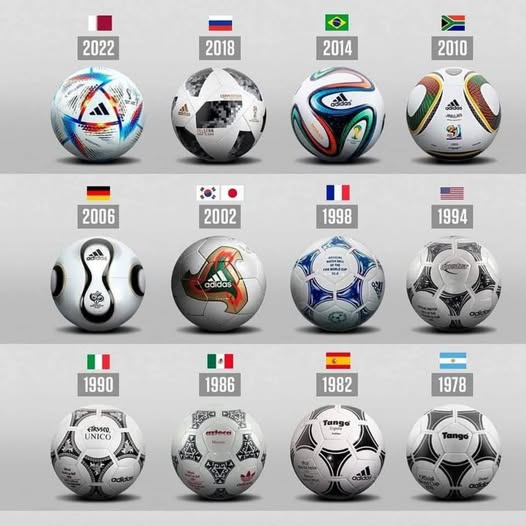
1. Beginnings of the Partnership
-
Adidas first started providing the official match ball to FIFA for the 1970 World Cup in Mexico.
-
The 1970 ball, called the Telstar, was designed for visibility on black-and-white television, with its distinctive black-and-white panel design. That helped cement Adidas’s role in defining what a World Cup match ball looks and feels like.
2. Match Balls: Innovation & Design
-
Since 1970, Adidas has supplied the official match ball for every FIFA World Cup.
-
Over time, the balls have evolved in materials, aerodynamics, design, and technology. Examples include:
• Azteca (1986) — first fully synthetic World Cup ball.
• Tricolore (1998) — first multicoloured World Cup final stage ball.
• Al Rihla (2022) — recent ball, with design inspired by tradition, environment, and travel (“The Journey”)
• Trionda (2026) — the upcoming official match ball for the 2026 World Cup, representing the three host countries (United States, Canada, Mexico) in its design.
3. Long‑Term Partnership & Rights
-
In November 2013, Adidas and FIFA extended their partnership until 2030. Under this agreement Adidas holds the Official Partner, Supplier, and Licensee rights for the FIFA World Cup and all FIFA events during that period.
-
The agreement includes the rights to supply match balls, furnish volunteers and referees uniforms, and produce licensed merchandise globally.
4. Other Activities: Apparel, Officials & Merchandise
-
Uniforms & Gear: Referees, volunteers, and officials at FIFA tournaments are outfitted in Adidas gear. National teams’ kits (jerseys, shorts) often come from Adidas in world tournaments where Adidas is the national supplier.
-
Licensed Products & Merchandise: Adidas produces licensed FIFA World Cup merchandise, from casual wear and replicas to special products tied to each tournament. These items are sold globally.
5. Grassroots & Development Programmes
-
Part of the deal includes working together on development and social responsibility programmes. Two of note are:
• FIFA Goal — providing footballs to national football associations; since 2008, Adidas & FIFA have made over 150,000 “FIFA Goal” balls available.
• Football for Hope / Adidas Exchange Programme — organising workshops, training seminars etc, especially in less-developed or community‑based football organisations.
6. Brand Image, Technology & Innovation
-
Adidas leverages the partnership to showcase innovations in football kit materials, match ball construction, panel technologies, aerodynamics, and graphics — all tied to the global showcase that FIFA events provide.Example: The 2026 ball (Trionda) includes modern design elements reflecting the host countries, technological features such as sensors, performance enhancement, and aesthetic details that tie to local identity.
7. Challenges & Controversies
-
As with large partnerships, there are occasional controversies — about pricing, environmental issues, labor behind merchandise production, and matching social responsibility expectations. Adidas has also been involved in discussions around human rights, especially leading up to major tournaments (e.g. in Qatar 2022), engaging with stakeholders, supply chain scrutiny, worker rights etc.
-
Sometimes sponsorship rights become points of negotiation or conflict. For example, more recently there has been a dispute between FIFA, Adidas, and Coca‑Cola over sponsorship rights for the expanded Club World Cup.
8. Impact & Significance
-
For FIFA, Adidas provides consistency, brand prestige, financial and logistical support, innovation, and merchandise revenue.
-
For Adidas, FIFA events are among the highest-visibility platforms in sport — World Cups reach billions of viewers — so being the match‑ball provider, official partner, and apparel/licensing supplier gives massive marketing value.
-
The partnership has helped to shape fan culture: iconic balls, memorable designs, collectables, and branding that tie Adidas into the emotional core of international football.
Conclusion
Adidas’s involvement with FIFA is deep and multifaceted: from designing the balls that define each tournament, to outfitting officials and volunteers, to supplying licensed merchandise and supporting grassroots development. Their long‑term agreement through 2030 ensures this will continue. While there are challenges — ethical, environmental, commercial — the Adidas‑FIFA partnership remains one of the foundational relationships in global sport.

You must be logged in to post a comment.